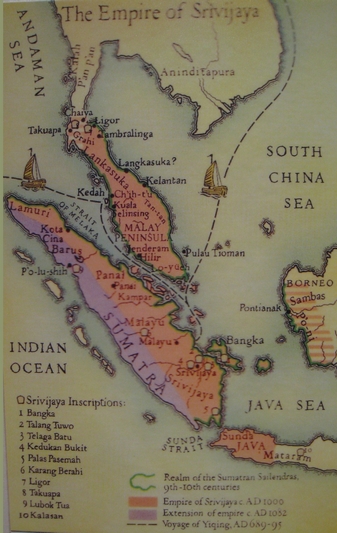Bujang Valley
 These archaeological remains indicate that there was a Hindu-Buddhist polity here. The name itself is roughly translated into Snake or Dragon Valley. The area consists of ruins that have been carbon dated to the 4th century. More than fifty ancient temples, called candi, have also been unearthed. The most impressive and well-preserved of these is located in Pengkalan Bujang, Merbok. The Bujang Valley Archaeological Museum is also located there.
These archaeological remains indicate that there was a Hindu-Buddhist polity here. The name itself is roughly translated into Snake or Dragon Valley. The area consists of ruins that have been carbon dated to the 4th century. More than fifty ancient temples, called candi, have also been unearthed. The most impressive and well-preserved of these is located in Pengkalan Bujang, Merbok. The Bujang Valley Archaeological Museum is also located there.Research indicates that there may have been a Hindu-Buddhist kingdom here possibly as early as 300 CE. If that were true, this would mean that local rulers may have adopted Indian cultural and political models earlier than those of Kutai in eastern Borneo, in southern Celebes or Tarumanegara in western Java, where remains showing Indian influence have been found dating from the early 5th century. Relics found in the Bujang Valley are now on display at the archaeological museum. Items include inscribed stone caskets and tablets, metal tools and ornaments, ceramics, pottery, inscriptions, Buddha Statues and Hindu icons.
 For the past two decades, students from universities around Malaysia have been invited for research and have done their graduate works at the Valley. Many of the historical links are still vague as not many writings survive. Even the temples did not survive the onslaught of the years because their wooden roofing has rotted and withered over the past 1200 years. Many of the findings from the Bujang Valley are scattered elsewhere from Museum Negara to Singapore. There are also accounts by the students that many of the religious findings have either been hidden or destroyed by the authorities.
For the past two decades, students from universities around Malaysia have been invited for research and have done their graduate works at the Valley. Many of the historical links are still vague as not many writings survive. Even the temples did not survive the onslaught of the years because their wooden roofing has rotted and withered over the past 1200 years. Many of the findings from the Bujang Valley are scattered elsewhere from Museum Negara to Singapore. There are also accounts by the students that many of the religious findings have either been hidden or destroyed by the authorities.Folk stories and oral history recount a magnificent kingdom of jewels and gold. Outside peninsular and insular Southeast Asia, there are some oral histories in India that suggest the presence of golden chariots and jewels in hidden caves at what may be the Bujang Valley and Mount Jerai. Some visitors to the antiquity department at Muzium Negara has eye-witness recollection of magnificent objects such as a 10 feet tall Raja Bersiung Throne and various idols and items from the Valley, which have now disappeared.
In Kedah there are remains showing Buddhist and Hindu influences which has been known for about a century now from the discoveries reported by Col. Low. These have recently been subjected to a fairly exhaustive investigation by Dr. Quaritch Wales. Dr. Wales investigated no fewer than thirty sites around Kedah. The results attained show that this site was the location of a Hindu-Buddhist polity similar to those found in western Indonesia.
An inscribed stone bar, rectangular in shape, bears the ye dharmma formula in Pallava script and dates from the fourth century A.D., thus proclaiming the Buddhist character of the shrine near the find-spot of which only the basement survives. It is inscribed on three faces in Pallava script of the sixth century CE, possibly earlier.
The Bujang Valley civilisation was part of the Srivijaya Empire, an ancient Malay kingdom centered on the island of Sumatra, Southeast Asia which influenced much of the Malay Archipelago. The earliest literary account of its existence dates from the 7th century; the Chinese monk, I-Tsing, wrote that he visited Srivijaya in 671 for 6 months. The first inscription in which the name Srivijaya appears also dates from the 7th century, namely the Kedukan Bukit Inscription around Palembang in Sumatra, dated 683. The kingdom ceased to exist between 1200 and 1300 due to various factors, including the expansion of the Hindu Kingdom of Majapahit. In Sanskrit, Sri means shining or radiant and Vijaya means victory or success.
Text adapted from Wikipedia (retrieved, July 5th 2009)


No comments:
Post a Comment